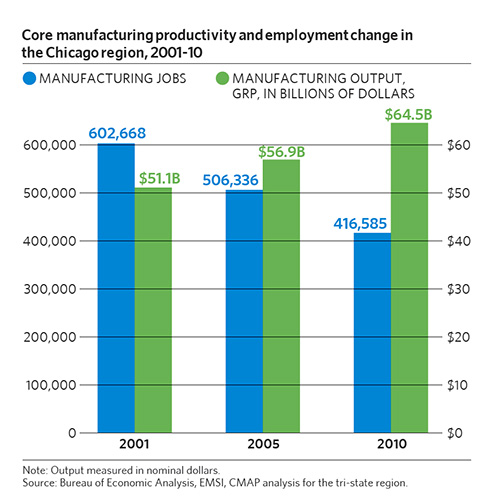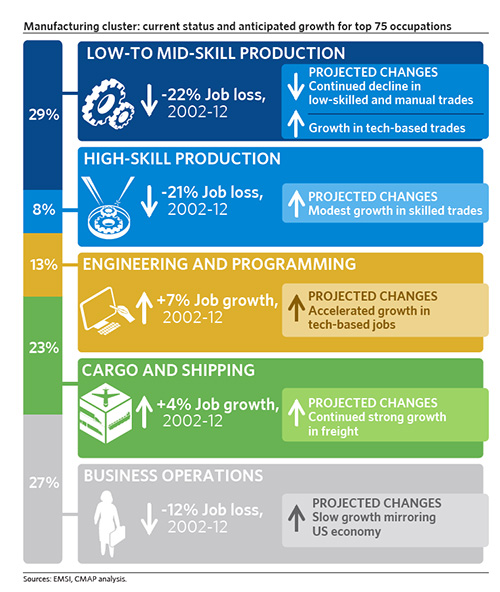Metropolitan Chicago's manufacturing cluster employs one in eight workers in the region. Although manufacturers lost one-third of their workforce between 2001 and 2011, productivity actually increased over that same period. These seemingly contradictory trends reveal how dramatically the region's manufacturing cluster has changed in recent years. CMAP's new manufacturing cluster drill-down report delves into how the region can better support this important component of our economy by building on the region's competitive advantages in innovation, infrastructure, and workforce. This Policy Update explores the changing skill requirements of the region's large and diverse manufacturing labor force.
Regional Changes in Manufacturing Productivity and Employment
Seemingly limitless globalization coupled with rapid advances in technology and shipping has changed where goods are manufactured and reshaped the skills needed in the region's manufacturing workforce. For instance, large-scale, low-skilled, and labor-intensive production -- where wages make up the larger portion of the manufacturer's cost -- has been offshored in the past several decades to low-wage countries. That type of manufacturing production is unlikely to return. In contrast, metropolitan Chicago remains highly competitive in advanced manufacturing. The region's workers can perform a wide variety of complex tasks, develop innovative solutions to improve manufacturing processes, and create more sophisticated or customized products to outcompete lower wage countries.

Historically, manufacturing has been a major employer in metropolitan Chicago. The cluster is still the second largest component of the region's economy today (following real estate). CMAP conducted a workforce analysis to better understand the regional manufacturing labor force. The chart below shows that in the cluster's top 75 occupations, significant job loss among production workers is expected to continue for low-skilled manual work that can be automated or offshored. However, growth is expected among mechanically inclined and technology-savvy production workers. The chart below also highlights how jobs associated with freight and logistics have grown over the past ten years, and that trend is projected to continue. Metropolitan Chicago has a key strategic advantage as the nation's freight and logistics hub (which CMAP described in the agency's first drill-down report on the freight cluster), and local manufacturers have utilized that strength.

Nationally, manufacturing has changed over the years, and metropolitan Chicago's diverse industries are well-positioned to compete. Today's economy demands more innovative products, just-in-time production, and increased customization, and the region's cluster has the potential to meet those demands. However, metropolitan Chicago needs more high-skilled production workers to build on its strengths in advanced manufacturing. This challenge is expected to grow because of significant baby-boomer retirement (an estimated 40 percent of the production workforce will leave the work force in the next 15 years), and currently the pipeline of workers is insufficient to fill those vacancies, let alone fill new positions created. There is a gap between skills and knowledge of the current labor force and what manufacturers need in order to grow. Innovation in the manufacturing cluster means that workers will also have to keep up with rapid product and process change. Beyond the acute shortage of skilled production workers, firms in the cluster need more workers that drive innovation, like engineers, technologists, and scientists.
Training the Advanced Manufacturing Workforce
To address the region's growing gaps in the manufacturing workforce, metropolitan Chicago must better coordinate and expand its existing vocational training programs, grow on-the-job training opportunities like internships and apprenticeships, and focus on long-term education challenges to attract more students to science, technology, engineering, and mathematics fields. Training programs across the region -- from non-profit organizations to high schools and community colleges -- all have a role to play. Many have already risen to the challenge; a recent Policy Update describes how Harper College and a large consortium of community colleges around the region are working with manufacturers to expand and improve advanced manufacturing training in northeastern Illinois. The ability of manufacturers to grow and thrive in the future will depend on the region's continued ability to cultivate a capable and skilled workforce.